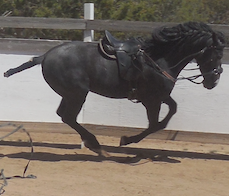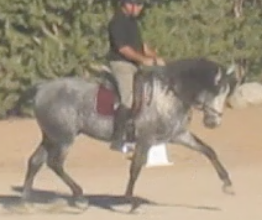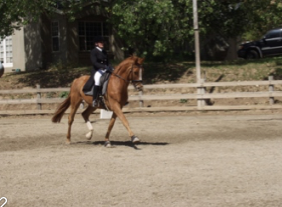Before continuing with an exploration of classical dressage principles, I want to clarify my reasons for doing so.
I do it because part of understanding dressage is understanding why we do it. Classical theory provides answers to that “why” for me. Those answers furthermore embody training principles which inform four areas of my horsemanship at present:
THE DRESSAGE PRINCIPLES OF CLASSICAL THEORY INFORM MY OWN DRESSAGE RIDING
I am alone in my dressage work now with my stallion, and I’m wondering what all the years of training and competition have taught me. Surely I’m capable of working through the presenting issues with my horse without having someone yelling in my ear all the time.
However, it is said that dressage is a coached sport. This is true at least insofar as one has her eye on the competition arena. Dressage in this venue is extremely precise, and one needs eyes on the ground to identify problems or good points that the rider may miss. But beyond the competition part, I’m convinced that an educated rider is capable of working on her own for at least some of the time.
DRESSAGE PRINCIPLES OF CLASSICAL THEORY INFORM MY WORK WITH MY P.R.E. STUD HORSE; THEY HELP CREATE A SAFE STALLION
This is the subject of a series of articles all by themselves, but I will touch on it briefly here.
I consider myself a horsewoman. As such, I am committed to learning all I can about the horse as a creature in all its shapes, forms, sizes, and sexes. But I have been warned long before I purchased my P.R.E. (Pura Raza Española) stallion Soñador that I shouldn’t own a stallion. I shouldn’t own one, ride one, or be around one, They’re too dangerous. In particular, I was told women shouldn’t own stallions. Really?
But in the Spanish Riding School of Vienna, that’s all they ride is stallions, all beautifully behaved as they perform their movements and drills. During a recent trip to Spain, I saw stallions behaving obediently in a circus of mares, geldings, baby strollers, tents, grandmothers and whatnot all mixed together during the annual trade fair for the Spanish horse in Seville, Spain called SICAB for short. But in this country we are told,
“If you’re not going to breed your stallion, you should geld him.”
I have come to the conclusion that ours is not a horse culture. And because of this, most riders in this country lack the experience and know how to deal with intact male horses. I want to be different. I want to the best of my ability learn to work with my stallion. Classical dressage is helping me do that.

The Young Stallion Soñador at Play
DRESSAGE PRINCIPLES OF CLASSICAL THEORY INFORM ANSWERS TO MY OWN QUESTIONS ABOUT MODERN DRESSAGE
My current study of Alois Podhajsky has as its purpose the recalling of experiences of the masters and applying them to the approach with which I was trained as a little girl and use now. Here are some questions which arise in this process: What are the principles and exercises which express those principles that can help achieve the forward, balance, straight, collection, impulsion I spoke of in my earlier article? How can we use these principles to diagnose problems and choose the right exercises to help us work through those problems?
One challenge in all this is trying to determine what modern terms such as “thoroughness” and “fancy mover” have to do with a classical approach discussed by Podhajsky, Perhaps I should define “classical.” By “classical” I mean the theory and practice which has been set down over centuries as the best and most effective way to train the horse to be an obedient riding partner who is responsive and capable of executing the rider’s will.
DRESSAGE PRINCIPLES OF CLASSICAL THEORY PROVIDE A COUNTERPOINT TO BREED BIAS AND FAD IN MODERN DRESSAGE
We now have “dressage horses,” and the best “dressage horses” are warmbloods who have been bred to conform to dressage standards; conversely, dressage standards reward those horses which so conform.
I’ve had two warmbloods on whom I did very well. Then I started showing my thoroughbred in dressage because my star warmblood became chronically lame. This horse, Spectacular Leap, has been a love of my life whom I purchased to be my jumping horse. He got converted late in life to dressage competition at age 16 when circumstances indicated I would have to do this to further my competition goals. We did well but not great. I distinctly remember one dressage test the scores of which clearly struck me as showing a bias against my horse because of his breed and way of going. Thoroughbreds like Arabian horses are flatter movers to accommodate the primary work they were bred to do — the former track racing, the latter long distance endurance.
I now have my lovely and talented P.R.E .stallion. Then I remember a dear friend of mine saying,
“What about the trot?” “Well, what about it?” I replied. “He trots.”
I told her I followed my heart, not convention; that I can train the necessary warmblood trot with suspension on him and that P.R.E.’s are known for their ability to collect. I had accomplished work at the lower levels of dressage and bought my P.R.E. to help me with the upper levels where collection becomes more of a requirement. Another friend told me,
“So is extension.”
He can extend too. But the issue was can he extend the way warmbloods do it. I am aware that we were now getting into the area of fad.
Just the other day my trainer, Joel Sheridan, and I trailered my stallion over to a neighbor’s ranch to expose him to other horses and let him see some new sights. While Joel was riding him, he began to demonstrate the kind of wonderful trot that is devoid of fad and bias but rather showed the classical pure gait that Podhajsky would be proud of. The trot was gorgeous and energetic, thrusting from behind with the forelegs reaching out in equal symmetry with the hind legs. It was beautiful, a true dressage competition 10 according to my estimation. But it was not a passage-like trot of the warmblood, and that’s the point.

Trot Demonstrated by P.R.E. Stallion Soñador. This is a young horse. It would be perfect if his poll was a bit higher like Huntington’s below.
The thing which characterizes the warmblood trot is his ability to hold the suspended period of the gait longer than other breeds. This has been bred into the horse. The trot is a two-beat gate with one diagonal pair of legs hitting the ground being one beat, followed a period of suspension after which the other diagonal pair of legs hits the ground; that’s the second beat. The extra milliseconds of suspension gives the horse’s trot that floaty impression. It is unquestionably a show stopper in the competition arena .

Warmblood Trot Shown by Huntington. We don’t see the suspension here, but the reader can compare the differences in expression between Soñador’s trot and Huntington’s.
But there are also some problems not the least of which is a passage-like trot I mentioned above. As we will see when I get into a discussion of Podhajsky, the emphasis must be on purity of the gaits. A trot must be a trot, a passage a passage and so on. There must not be any cross-over so that the onlooker is confused by what s/he is looking at.
Another problem is how this adoration of the warmblood suspension in the trot when emulated by other breeds becomes a time waster as far as practical work goes. I wouldn’t want my endurance race horse spending time in the air during the suspension phase of the trot only to squander the time we need to go forward to win a race. But this same value may not carry over into the dressage competition arena where the emphasis becomes one’s horse’s ability to wow the judges with a suspended trot regardless of whether or not this ability serves any useful purpose.
This leads me to the question,
“Don’t dressage horses have some other job that they need dressage for to help them do their primary job better?”
P.R.E.’s were battle and bull fighting horses. Now they excel in working equitation, a sport from Portugal, which combines a dressage test with ease of handling and speed trial to continue to test their ability to do the work they were culturally bred for throughout the ages.
CONCLUSION AND CALL TO ACTION
Classical dressage theory is behind the pursuit of the well ridden, versatile horse. Understanding this theory has worth for every horse regardless of discipline. I will continue in succeeding articles to build on that understanding, its history and practical application.
I would appreciate the reader’s comments on this article below. Please tell me what you think.
Great Content and Information. Thanks for this concise and thorough article. This is a great and simple to follow guide on understanding dressage.
You laid it all out clearly and showed examples that helped emphasize your various points. First of all, your reasons for choosing this niche is motivating.
This is the type of information some so-called professional bloggers will love to hide from public knowledge. I’m so happy I found your blog
Thank you for your support.
Lovely post on this topic. I like your motivation and drive.I never knew stallions can be used for dressage so I thought they were exempt. I love the way you are determined to prove that can be used for dressage and I think it will take a deep understanding of dressage to pull this off. You have my best wishes and I will be keeping up with future posts to find out how it works out. All the best
Thank you. I plan to write more about stallions and how to work with them.
this is an awesome article. I now understand more about dressage, applying principles and all. My question for someone who is trying to go into dressage what will be your advice to him?, What are the steps or recommendations on how to go about it will you give yo the person?. I will be looking forward to your reply. Thanks for sharing this information.
Thanks. I have written down your questions for a further article.
Awesome InformationWhat an incredible blog post!I really love the way you outlined the review on understanding dressage and how you have made your intentions so clear enough to comprehend. I must say this is an eye opener; I cannot help but agree with everything that you had writtenThis is one of the most extensive article i have ever read.
Great that you see the article as an eye opener.
Nice work! I love how you took out time to explain and clarify what dressage is and how it relates to you. You caught me with the part where you wrote that “Don’t dressage horses have some other job that they need dressage for to help them do better?” Well, I always believe that horses could use dressage to do more than just sports. So to me, they do.
I really appreciate your support.
Thanks for writing this article on understanding dressage.i must say a very well done job to you for posting such a motivational article on your struggle despite people try to talk you out that women shouldn’t own stallions.
as a woman I must say you really take up work and becoming a dressage.i hope those this serve as a motivation to many never not to give up on what they believe in or have passion for in life
Thank you so much.
This is really interesting Carole. I have never ridden dressage and only have limited experience with horses but I love watching them and enjoyed the little bit of riding I did.
I think it is great you are pushing the boundaries and expectations a bit and showing that old assumptions are not always correct. It seems silly and limiting to assume a woman should not ever have a stallion! Good for you for showing that does not have to be the case.
Many cultural norms are simply the result of indoctrination and have little relevance or basis in fact. They are myths that get perpetuated over time until they become excepted “fact”. I am one of those people that look for these myths that have become “fact” and challenge them.
I will enjoy reading more of your posts here on your site.
Jessica
Thanks, Jessica. Very interesting how myth becomes fact. Carole
Thank you Carole for this extensive post on understanding dressage; clarifying my intention. It was an interesting read, I’m happy you know what you want and despite the initial discouragement even as a horsewoman you held on to what you believe you can achieve with your stallion. in America here, we lack the patience of training and making stallion to adapt compared to what you saw in seville. Your faith in the application of the principal of classical riding to modern dressage paid off. This is quite inspiring.
The onl few things I can say about your article are these. I expected you to explain explicitly what a dressage is. You didn’t give an explicit and crystal explanation of the meaning of dressage and not everyone will comprehend it the way you wrote it. Secondly, in your principles about dressage, it wasn’t outlined for easy understanding.
Thanks for sharing this article on your understanding of dressage. Every individual must have something that inspires or motivates them in doing what they do. It’s cool to know you are into horse sport. I don’t really know much about horse gender, sex or even differentiate a male from female. How can I know a male horse or female when I see one? Thanks
Not being a horse race enthusiast,I must confess that I didn’t understand some of the terms so I had to do a little research but what got me to continue reading is the rebellion -like desire to change status quo. To prove to everyone that something they said was impossible could actually be possible. I really love people who question status quo with as much passion as you do. It motivates me and I bet you, even if it does not happen for you and your PRE Stallion now, that in the future, the work and passion you have put into letting them know that Stallions can do as perfect trots or extensions as warmbloods can would definitely pay off. The changes we enjoy today were started by someone or some people. People put them down, friends might have told them to be realistic but they tugged on and today, their names are mentioned for bringing about those changes or even change in perspective.
If you believe that you can train the necessary warm-blooded trot on your PRE stallion, please do not give up. I’ll be here rooting for you, always. You go girl!!
Thanks. Looks like I’m going to have to define my terms better. Carole